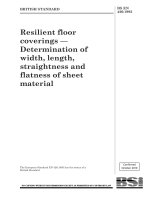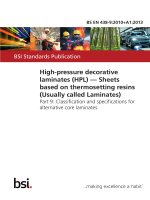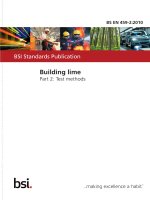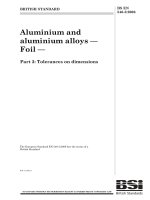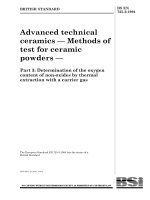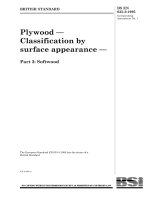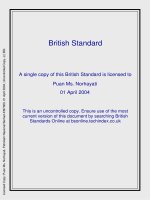Bsi bs en 62333 3 2010
Bạn đang xem bản rút gọn của tài liệu. Xem và tải ngay bản đầy đủ của tài liệu tại đây (948.1 KB, 16 trang )
BS EN 62333-3:2010
BSI Standards Publication
Noise suppression sheet for
digital devices and equipment
Part 3: Characterization of parameters of noise
suppression sheet
BRITISH STANDARD
BS EN 62333-3:2010
National foreword
This British Standard is the UK implementation of EN 62333-3:2010. It is
identical to IEC 62333-3:2010.
The UK participation in its preparation was entrusted to Technical Committee
EPL/51, Transformers, inductors, magnetic components and ferrite materials.
A list of organizations represented on this committee can be obtained on
request to its secretary.
This publication does not purport to include all the necessary provisions of a
contract. Users are responsible for its correct application.
© BSI 2010
ISBN 978 0 580 61821 5
ICS 29.100.10
Compliance with a British Standard cannot confer immunity from
legal obligations.
This British Standard was published under the authority of the Standards
Policy and Strategy Committee on 31 March 2010.
Amendments issued since publication
Amd. No.
Date
Text affected
BS EN 62333-3:2010
EN 62333-3
EUROPEAN STANDARD
NORME EUROPÉENNE
EUROPÄISCHE NORM
February 2010
ICS 29.100.10
English version
Noise suppression sheet for digital devices and equipment Part 3: Characterization of parameters of noise suppression sheet
(IEC 62333-3:2010)
Plaque réduisant le bruit des dispositifs
et appareils numériques Partie 3: Caractérisation des paramètres
des plaques réduisant le bruit
(CEI 62333-3:2010)
Rauschunterdrückungsschicht
für digitale Geräte und Einrichtungen Teil 3: Eigenschaften von Parametern
der Rauschunterdrückungsschicht
(IEC 62333-3:2010)
This European Standard was approved by CENELEC on 2010-02-01. CENELEC members are bound to comply
with the CEN/CENELEC Internal Regulations which stipulate the conditions for giving this European Standard
the status of a national standard without any alteration.
Up-to-date lists and bibliographical references concerning such national standards may be obtained on
application to the Central Secretariat or to any CENELEC member.
This European Standard exists in three official versions (English, French, German). A version in any other
language made by translation under the responsibility of a CENELEC member into its own language and notified
to the Central Secretariat has the same status as the official versions.
CENELEC members are the national electrotechnical committees of Austria, Belgium, Bulgaria, Croatia, Cyprus,
the Czech Republic, Denmark, Estonia, Finland, France, Germany, Greece, Hungary, Iceland, Ireland, Italy,
Latvia, Lithuania, Luxembourg, Malta, the Netherlands, Norway, Poland, Portugal, Romania, Slovakia, Slovenia,
Spain, Sweden, Switzerland and the United Kingdom.
CENELEC
European Committee for Electrotechnical Standardization
Comité Européen de Normalisation Electrotechnique
Europäisches Komitee für Elektrotechnische Normung
Central Secretariat: Avenue Marnix 17, B - 1000 Brussels
© 2010 CENELEC -
All rights of exploitation in any form and by any means reserved worldwide for CENELEC members.
Ref. No. EN 62333-3:2010 E
BS EN 62333-3:2010
EN 62333-3:2010
-2-
Foreword
The text of document 51/970/FDIS, future edition 1 of IEC 62333-3, prepared by IEC TC 51, Magnetic
components and ferrite materials, was submitted to the IEC-CENELEC parallel vote and was approved by
CENELEC as EN 62333-3 on 2010-02-01.
Attention is drawn to the possibility that some of the elements of this document may be the subject of
patent rights. CEN and CENELEC shall not be held responsible for identifying any or all such patent
rights.
The following dates were fixed:
– latest date by which the EN has to be implemented
at national level by publication of an identical
national standard or by endorsement
(dop)
2010-11-01
– latest date by which the national standards conflicting
with the EN have to be withdrawn
(dow)
2013-02-01
Annex ZA has been added by CENELEC.
__________
Endorsement notice
The text of the International Standard IEC 62333-3:2010 was approved by CENELEC as a European
Standard without any modification.
In the official version, for Bibliography, the following notes have to be added for the standards indicated:
IEC 60695-11-10
NOTE Harmonized as EN 60695-11-10.
IEC 62321
NOTE Harmonized as EN 62321:2009 (not modified).
IEC 62333-1
NOTE Harmonized as EN 62333-1:2006 (not modified).
IEC 62333-2
NOTE Harmonized as EN 62333-2:2006 (not modified).
__________
BS EN 62333-3:2010
-3-
EN 62333-3:2010
Annex ZA
(normative)
Normative references to international publications
with their corresponding European publications
The following referenced documents are indispensable for the application of this document. For dated
references, only the edition cited applies. For undated references, the latest edition of the referenced
document (including any amendments) applies.
NOTE When an international publication has been modified by common modifications, indicated by (mod), the relevant EN/HD
applies.
Publication
Year
Title
EN/HD
Year
1)
IEC 60068-1
1988
Environmental testing Part 1: General and guidance
EN 60068-1
1994
IEC 60068-2-1
-
Environmental testing Part 2-1: Tests - Test A: Cold
EN 60068-2-1
-
IEC 60068-2-2
-
Environmental testing Part 2-2: Tests - Test B: Dry heat
EN 60068-2-2
-
IEC 60093
-
HD 429 S1
Methods of test for volume resistivity and
surface resistivity of solid electrical insulating
materials
-
ISO 527-1
-
Plastics - Determination of tensile properties - Part 1: General principles
-
ISO 1183-1
2004
Plastics - Methods for determining the density of non-cellular plastics Part 1: Immersion method, liquid pyknometer
method and titration method
-
ISO 3611
-
Micrometer callipers for external
measurement
-
-
ISO 22007-1
-
Plastics - Determination of thermal
conductivity and thermal diffusivity Part 1: General principles
-
-
ISO 22007-2
-
Plastics - Determination of thermal
conductivity and thermal diffusivity Part 2: Transient plane heat source (hot disc)
method
-
ISO 22007-3
-
Plastics - Determination of thermal
conductivity and thermal diffusivity Part 3: Temperature wave analysis method
-
-
ISO 22007-4
-
Plastics - Determination of thermal
conductivity and thermal diffusivity Part 4: Laser flash method
-
-
1)
EN 60068-1 includes A1 to IEC 60068-1
+ corr. October .
BS EN 62333-3:2010
–2–
62333-3 IEC:2010
CONTENTS
INTRODUCTION.....................................................................................................................5
1
Scope ...............................................................................................................................6
2
Normative references .......................................................................................................6
3
Terms and definitions .......................................................................................................7
4
General ............................................................................................................................7
5
Parameters, descriptions and measuring methods ............................................................8
Material properties ..................................................................................................8
5.1.1 Surface resistivity ........................................................................................8
5.1.2 Mechanical characteristics...........................................................................8
5.1.3 Thermal conductivity....................................................................................8
5.1.4 Environmental conditions.............................................................................9
5.1.5 Statement for non-usage of the prohibited chemical materials ................... 10
5.2 Structure ............................................................................................................... 10
5.2.1 Thickness .................................................................................................. 10
5.2.2 Layer structure .......................................................................................... 10
Bibliography.......................................................................................................................... 11
5.1
Figure 1 – Framework of IEC 62333 series for noise suppression sheet..................................5
Figure 2 – Schematic diagram of thermal conductivity measuring apparatus ........................... 9
Figure 3 – Structure of NSS .................................................................................................. 10
Table 1 – Structural example ................................................................................................ 10
BS EN 62333-3:2010
62333-3 IEC:2010
–5–
INTRODUCTION
There are established standards for noise suppression sheet (NSS) as in IEC 62333-1 and in
IEC 62333-2.
Figure 1 shows the framework of IEC 62333 series for NSS.
Part 1 issues the general guidelines of IEC 62333 series. Part 2 establishes measurement
methods of four important suppression ratios for NSS.
This Part 3 specifies characterization of each parameter except suppression ratio of NSS,
which is determined in Part 2. Parameters prescribed in this part are divided into material
properties and structure.
IEC 62333-1
Part 1: Definitions and
general properties
Suppression ratio
(R da , R de , R tp and R rs )
Others
IEC 62333-2 and IEC 62333-3
Part 2: Measuring methods
Suppression ratio (R da , R de , R tp and R rs )
Part 3: Characterization of parameters of noise
suppression sheet
Material properties
Structure
IEC
Figure 1 – Framework of IEC 62333 series for noise suppression sheet
2618/09
BS EN 62333-3:2010
–6–
62333-3 IEC:2010
NOISE SUPPRESSION SHEET FOR DIGITAL
DEVICES AND EQUIPMENT –
Part 3: Characterization of parameters of noise suppression sheet
1
Scope
This part of IEC 62333 provides characterization of parameters for electromagnetic noise
suppression sheet (NSS) for digital devices and equipment used in a frequency range
between 30 MHz to 30 GHz. Guidance is given for uniform presentation of the properties of
noise suppression sheet, intended for use in manufacturers and users technical data. NSS
suppresses noise at its source, rather than absorbing noise at a distance. Therefore NSS is
distinguished from RF wave absorbers used in free space.
This standard addresses the following purposes of NSS manufacturers and users:
–
it assists users in understanding the published technical data in catalogues;
–
it guides users in selecting the most preferable NSS for each application;
–
it establishes measurement benchmarking for manufacturers of performance in new
development of NSS; and
–
it maintains high reliability of NSS and applied products.
The numerical values given in this standard are typical values of parameters (properties) of
the related NSS. The purpose of NSS testing is the benchmarking of materials. Predictions of
specific device performance values are not always easy or even possible.
Every detailed material and NSS specification should be agreed between the user and the
manufacturer.
2
Normative references
The following referenced documents are indispensable for the application of this document.
For dated references, only the edition cited applies. For undated references, the latest edition
of the referenced document (including any amendments) applies.
IEC 60068-1:1988, Environmental testing – Part 1: General and guidance
IEC 60068-2-1, Environmental testing – Part 2-1: Tests – Test A: Cold
IEC 60068-2-2, Environmental testing – Part 2-2: Tests – Test B: Dry heat
IEC 60093, Methods of test for volume resistivity and surface resistivity of solid electrical
insulating materials
ISO 527-1, Plastics – Determination of tensile properties – Part 1: General principles
ISO 1183-1:2004, Plastics – Methods for determining the density non-cellular plastics – Part 1:
immersion method, liquid pyknometer method and titration method
ISO 3611, Micrometer callipers for external measurement
BS EN 62333-3:2010
62333-3 IEC:2010
–7–
ISO 22007-1, Plastics – Determination of thermal conductivity and thermal diffusivity – Part 1:
General principles
ISO 22007-2, Plastics – Determination of thermal conductivity and thermal diffusivity – Part 2:
Transient plane heat source (Hot Disc) method
ISO 22007-3, Plastics – Determination of thermal conductivity and thermal diffusivity – Part 3:
Temperature wave analysis method
ISO 22007-4, Plastics – Determination of thermal conductivity and thermal diffusivity – Part 4:
Laser flash method
3
Terms and definitions
For the purposes of this document, the following terms and definitions apply.
3.1
density
ρ
3
3
ratio of the mass of a sample to its volume, expressed in kg/m or g/cm
3.2
specific gravity
ratio of material density (mass per unit volume) at 23 °C to the density of gas-free distilled
water at 23 °C
3.3
tensile strength
σ M (Young’s modulus, Et)
maximum tensile stress sustained by the test specimen during a tensile test. It is expressed in
MPa
[ISO 527-1:1993, definition 4.3.3]
4
General
In selecting the optimum NSS, apart from the noise suppression ratios specified in Part 2,
material properties and structure are important factors.
Part 3 hereby, specifies measurement methods and data presentation methods of each
parameter except suppression ratio of NSS.
Part 2 gives guidance on suppression characteristics and this part gives guidance on the
characteristics of NSS with regards to material properties and structure.
The material properties in this standard consist of
–
surface resistivity;
–
mechanical characteristics (density, Young’s modulus and/or hardness);
–
thermal characteristics (thermal conductivity, thermal expansion coefficient);
–
environmental conditions (operating and/or storage temperature, flammability).
These parameters are required for indicating the installation availability and reliability after
long time usage.
The structures in this standard consist of
–
thickness;
BS EN 62333-3:2010
–8–
–
62333-3 IEC:2010
layer structure.
These parameters are closely related to the four specific noise suppression effects prescribed
in Part 2.
NOTE 1 The adhesive will have a direct influence on material properties. The definitions in this part are for NSS
without adhesive. Manufacturers and users should make specific agreement concerning properties with adhesive.
NOTE 2 Permeability is not a defined NSS material characteristic or structure. Permeability is considered by the
manufacturer in the design of the material, to achieve the target suppression properties in Part 2.
NOTE 3 Manufacturers often recommend frequency ranges in their datasheets based on typical applications and
operating conditions. Therefore, recommended frequency range is not included in material properties of this
standard.
5
Parameters, descriptions and measuring methods
5.1
Material properties
5.1.1
Surface resistivity
Surface resistivity shall
IEC 60093:1980.
be
determined,
and
the
results
reported,
as
specified
in
Surface resistivity is the quotient of a d.c. electric field strength, and the linear current density
in a surface layer of NSS. In practice it is taken as the surface resistance reduced to a square
area. The size of the square is immaterial.
NOTE The SI unit of surface resistivity is the ohm (Ω). In practice, this is sometimes referred to as “ohms per
square”.
5.1.2
5.1.2.1
Mechanical characteristics
Density
Density shall be determined, and the results reported, by method A specified in ISO 1183-1.
5.1.2.2
Specific gravity
Specific gravity can be converted to density (kg/cm 3 or g/cm 3 ) by multiplying specific gravity
by 9,975x10 –4 or 0,997 5, respectively.
5.1.2.3
Tensile strength (Young’s modulus)
Tensile testing is performed by elongating a specimen and measuring the load carried by the
specimen. From knowledge of the specimen dimensions, the load and deflection data can be
translated into a stress-strain curve.
Results shall be reported as described in ISO 527-1.
5.1.3
Thermal conductivity
a) Thermal conductivity (λ) shall be determined with λ = α·Cp·ρ, where, α is thermal
diffusivity, Cp is specific heat and ρ is density. Thermal diffusivity can be measured and
determined by the following standards: ISO 22007-1, ISO 22007-2, ISO 22007-3 and ISO
22007-4. The measuring standard used shall be identified, and the results shall be
reported as described in that standard.
b) Thermal conductivity should be measured under the standard atmospheric conditions
specified in 5.3.1 of IEC 60068-1:1988.
c) If additional data is necessary, the physical structure of the test and the test conditions
should be noted.
BS EN 62333-3:2010
62333-3 IEC:2010
–9–
Figure 2 shows a schematic diagram of measuring apparatus. (Reference from Figure 1 of
ISO 22007-3.)
Temperature
controller
Function
synthesizer
Reference
signal
Substrate
Heater
Personal
computer
Thermometer
Specimen
Substrate
Substrate
Specimen
holder
Sensor
Digital
multimeter
Furnace
Lock-in
amplifier
Bias current circuit
IEC
2619/09
Figure 2 – Schematic diagram of thermal conductivity measuring apparatus
Environmental conditions
5.1.4
5.1.4.1
Operating temperature
Operating temperature range should be guaranteed within –30 % variation of x, where x = 1 –
10 (–Rtp/10) at 20 °C.
The measurement frequency should be described.
5.1.4.2
Storage temperature
Highest and lowest storage temperatures should be guaranteed within –30 % variation of x,
where x = 1 – 10 (–Rtp/10) , after NSS is removed from each storage temperature to 20 °C.
The measurement frequency should be described. Storage temperature and storage time
should be prescribed by test “Ab” specified in IEC 60068-2-1 and test “Bb” specified in
IEC 60068-2-2.
5.1.4.3
Flammability
Manufacturer’s datasheet for NSS should report whether or not the material is compliant with
flammability safety requirements.
NOTE
For example, IEC 60695-11-10 or UL94 grade.
BS EN 62333-3:2010
– 10 –
62333-3 IEC:2010
Statement for non-usage of the prohibited chemical materials
5.1.5
5.1.5.1
RoHS
Manufacturer’s datasheet for NSS should report whether or not the material is compliant with
RoHS environmental requirements.
NOTE
For example, IEC 62321:2008.
5.1.5.2
Other prohibited chemical materials
Statement of other prohibited chemical materials can be described, if necessary.
5.2
5.2.1
Structure
Thickness
Thickness of NSS should be measured using a micrometer with an accuracy of ±0,02 mm,
according to ISO 3611, having faces with diameters between (5 to 30) mm.
5.2.2
Layer structure
Layer structure of NSS should be reported referencing the types and structures shown in
Table 1. “Magnetic” layer is a magnetic dielectric or a magnetic dielectric composite. “Nonmagnetic” layer is a conductive or a dielectric material.
Figure 3 shows the structure of NSS.
Table 1 – Structural example
Type
Structure and materials of each layer
Single layer
Magnetic
Figure 3a
Double layered
Magnetic + non-magnetic
Figure 3b
Multi layered
Magnetic + non-magnetic
Figure 3c
IEC
2620/09
Figure 3a – Single layer
IEC
2621/09
Figure 3b – Double layered
IEC
2622/09
Figure 3c – Multi layered
Figure 3 – Structure of NSS
BS EN 62333-3:2010
62333-3 IEC:2010
– 11 –
Bibliography
IEC 60695-11-10, Fire hazard testing – Part 11-10: Test flames – 50 W horizontal and vertical
flame test methods
IEC 62321:2008, Electrotechnical products – Determination of levels of six regulated
substances (lead, mercury, cadmium, hexavalent chromium, polybrominated biphenyls,
polybrominated diphenyl ethers)
IEC 62333-1:2006, Noise suppression sheet for digital devices and equipment – Part 1:
Definitions and general properties
IEC 62333-2:2006, Noise suppression sheet for digital devices and equipment – Part 2:
Measuring methods
___________
This page deliberately left blank
This page deliberately left blank
NO COPYING WITHOUT BSI PERMISSION EXCEPT AS PERMITTED BY COPYRIGHT LAW
British Standards Institution (BSI)
BSI is the national body responsible for preparing British Standards and other
standards-related publications, information and services.
BSI is incorporated by Royal Charter. British Standards and other standardization
products are published by BSI Standards Limited.
About us
Revisions
We bring together business, industry, government, consumers, innovators
and others to shape their combined experience and expertise into standards
-based solutions.
Our British Standards and other publications are updated by amendment or revision.
The knowledge embodied in our standards has been carefully assembled in
a dependable format and refined through our open consultation process.
Organizations of all sizes and across all sectors choose standards to help
them achieve their goals.
Information on standards
We can provide you with the knowledge that your organization needs
to succeed. Find out more about British Standards by visiting our website at
bsigroup.com/standards or contacting our Customer Services team or
Knowledge Centre.
Buying standards
You can buy and download PDF versions of BSI publications, including British
and adopted European and international standards, through our website at
bsigroup.com/shop, where hard copies can also be purchased.
If you need international and foreign standards from other Standards Development
Organizations, hard copies can be ordered from our Customer Services team.
Subscriptions
Our range of subscription services are designed to make using standards
easier for you. For further information on our subscription products go to
bsigroup.com/subscriptions.
With British Standards Online (BSOL) you’ll have instant access to over 55,000
British and adopted European and international standards from your desktop.
It’s available 24/7 and is refreshed daily so you’ll always be up to date.
You can keep in touch with standards developments and receive substantial
discounts on the purchase price of standards, both in single copy and subscription
format, by becoming a BSI Subscribing Member.
PLUS is an updating service exclusive to BSI Subscribing Members. You will
automatically receive the latest hard copy of your standards when they’re
revised or replaced.
To find out more about becoming a BSI Subscribing Member and the benefits
of membership, please visit bsigroup.com/shop.
With a Multi-User Network Licence (MUNL) you are able to host standards
publications on your intranet. Licences can cover as few or as many users as you
wish. With updates supplied as soon as they’re available, you can be sure your
documentation is current. For further information, email
BSI Group Headquarters
389 Chiswick High Road London W4 4AL UK
We continually improve the quality of our products and services to benefit your
business. If you find an inaccuracy or ambiguity within a British Standard or other
BSI publication please inform the Knowledge Centre.
Copyright
All the data, software and documentation set out in all British Standards and
other BSI publications are the property of and copyrighted by BSI, or some person
or entity that owns copyright in the information used (such as the international
standardization bodies) and has formally licensed such information to BSI for
commercial publication and use. Except as permitted under the Copyright, Designs
and Patents Act 1988 no extract may be reproduced, stored in a retrieval system
or transmitted in any form or by any means – electronic, photocopying, recording
or otherwise – without prior written permission from BSI. Details and advice can
be obtained from the Copyright & Licensing Department.
Useful Contacts:
Customer Services
Tel: +44 845 086 9001
Email (orders):
Email (enquiries):
Subscriptions
Tel: +44 845 086 9001
Email:
Knowledge Centre
Tel: +44 20 8996 7004
Email:
Copyright & Licensing
Tel: +44 20 8996 7070
Email:

